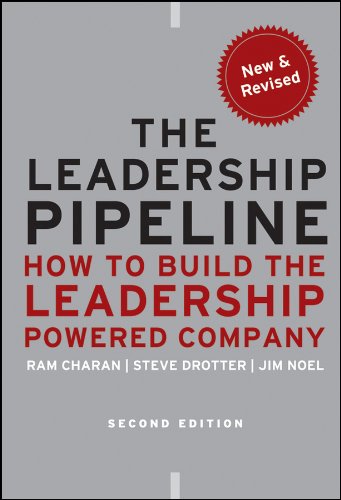In The leadership pipeline summary, I will share the ideas I liked the most from the book briefly.
In today’s rapidly changing world, businesses need to have a competitive advantage in financial capital and intellectual capital.
Intellectual capital can be developed and nurtured at all levels in the organization. However, it takes strong leadership for that.
We live in a time when the demand for leaders is higher than the supply, and most organizations tend to search for “talent” for their leadership roles.
And these new recruits are happy to move from company to company, living organization to square one.

Accept that the current internal training, promotions, performance measurement, and other initiatives are not enough to keep the leadership pipeline full, and we need to hire talent from outside.
In the leadership pipeline summary, we will see what methods Ram Charan and the team share for leadership pipeline and succession planning?
What is the key takeaway from The leadership pipeline summary?
- Why should you buy this book?
- What are the six leadership passages?
- How to clarify roles and performance standards?
Why should you read this book?
The leadership pipeline- How to build the leadership-powered company is authored by Ram Charan, Stephen Drotter, and James Noel.
In this book, you will get practical advice and tools that can be implemented by managers and human resources professionals.
Especially for HR professionals and entrepreneurs, this book can serve as a framework for succession planning.
Read this book, and you will learn.
- How can you integrate the leadership development process with succession planning?
- How can you improve performance by creating performance standards and clarifying roles in your organization?
- How to use a proven method of creating a leadership pipeline?
- How to identify and troubleshoot performance-related and leadership pipeline-related issues.
What are the six leadership passages?
In the leadership pipeline summary, we will see the six leadership passages shared by Ram Charan and the team.
Establishing six leadership passages will serve the organization in many ways, like for succession planning, employees can see their career path, employee development, and better hiring decisions.
Six leadership passages are
- From managing self to managing others
- From managing others to managing managers
- From managing managers to managing functional managers
- From functional manager to business manager
- From business manager to group manager
- From group manager to enterprise manager
Passage 1 – From managing self to managing others.
The most challenging part of this transition is managers who were individual contributors so far are now required to get work done from others.

Sometimes first-time managers are ready for this transition intellectually, but not psychologically. As a result, they become too strict managers or remain individual contributors.
At this passage of leadership, first-time managers need to understand they now need to learn people skills apart from technical skills they already have.
What can management do for a smooth transition?
Management needs to take three measures: prepare, monitor, and intervene as and when required.
Prepare them
Provide required soft skill training and orientation to clearly communicate what is expected from the manager and how they can achieve that?
Monitor them
Observe any new managers having any difficulties if they require more support or resources.
Intervene
Regular feedback on how they are doing as a manager and some coaching will help to smoothen the transition.
Passage 2 – From managing others to managing managers
Most organizations may have some training program for their first-time managers but may not have anything for managers of managers.

While first-time managers are celebrated, managers of managers get the silent treatment.
Managers of managers directly impact productivity and quality in the organization as they directly impact the work of many other team members.
What managers of should managers do to succeed?
To succeed as managers of managers, they must learn these four skills,
- Hiring and training first-line for managers
- Get accountability of first-line managers on managerial work.
- Making resources available to the team
- Managing boundaries in the team. (reporting structure)
Passage 3 – From managing managers to functional managers
You must have observed that many young high performers are now promoted to functional managers. While they may be excellent in technical skills, they may still lack people skills and maturity.
At this passage of the leadership pipeline, leaders must exhibit maturity acquired from experiences of success and failures.
What can management do?
To help these managers grow, learn and become mature, management can put them in task forces and projects where they need to interact with cross-functional managers.
To check development progress made by the leader, management must check on maturity shown by managers.
Passage 4 – From functional manager to business managers
The business manager gets relatively complex managers to manage. Functional managers are technically brilliant managers with now somewhat managerial experience.
As a business manager’s boss, management can take the following actions.
- Ask business managers to meet all functional managers to build rapport, these meetings can be set a fixed interval.
- Set specific goals for business managers linking all functions and service department so it can hold mutual accountability.
- Suggest business manager to groom functional manager for next level, this can be done by one to one mentoring or simply involving them in decision making.
Passage 5 – From business managers to group managers
At this stage, managers must manage more than one business in the organization. This will give them an understanding of other business models.
Group managers need to learn skills like strategy, asking the right questions, and helping teams build better leaders down the line.
To help, leaders as the level organization should invest in executive coaching and team coaching.
Passage 6 – From group managers to enterprise managers
At this stage, leaders must show the highest level of the system of beliefs, values, and ethics that holds an organization together.
Ideally, CEOs at this level must have gone through all 5 passages mentioned in the book.
The development of a CEO requires tailor-made intervention and mentoring from past leaders in the organization.
How to clarify roles and performance standards?
The leadership pipeline can be the best tool for clarity and performance standards for leaders at all levels.
It can compare what a leader does against what is required by leaders.
Here are some of the strategies to get the best performance.
- Start with the boss and not the subordinate.
- Search for evidence of an appropriate values shift.
- Use Action Learning as a primary method for development.
- Address inappropriate performance immediately.
So this was the leadership pipeline summary. Let me know if you wish me to write a summary for a book of your choice.
Check out some more book summaries



